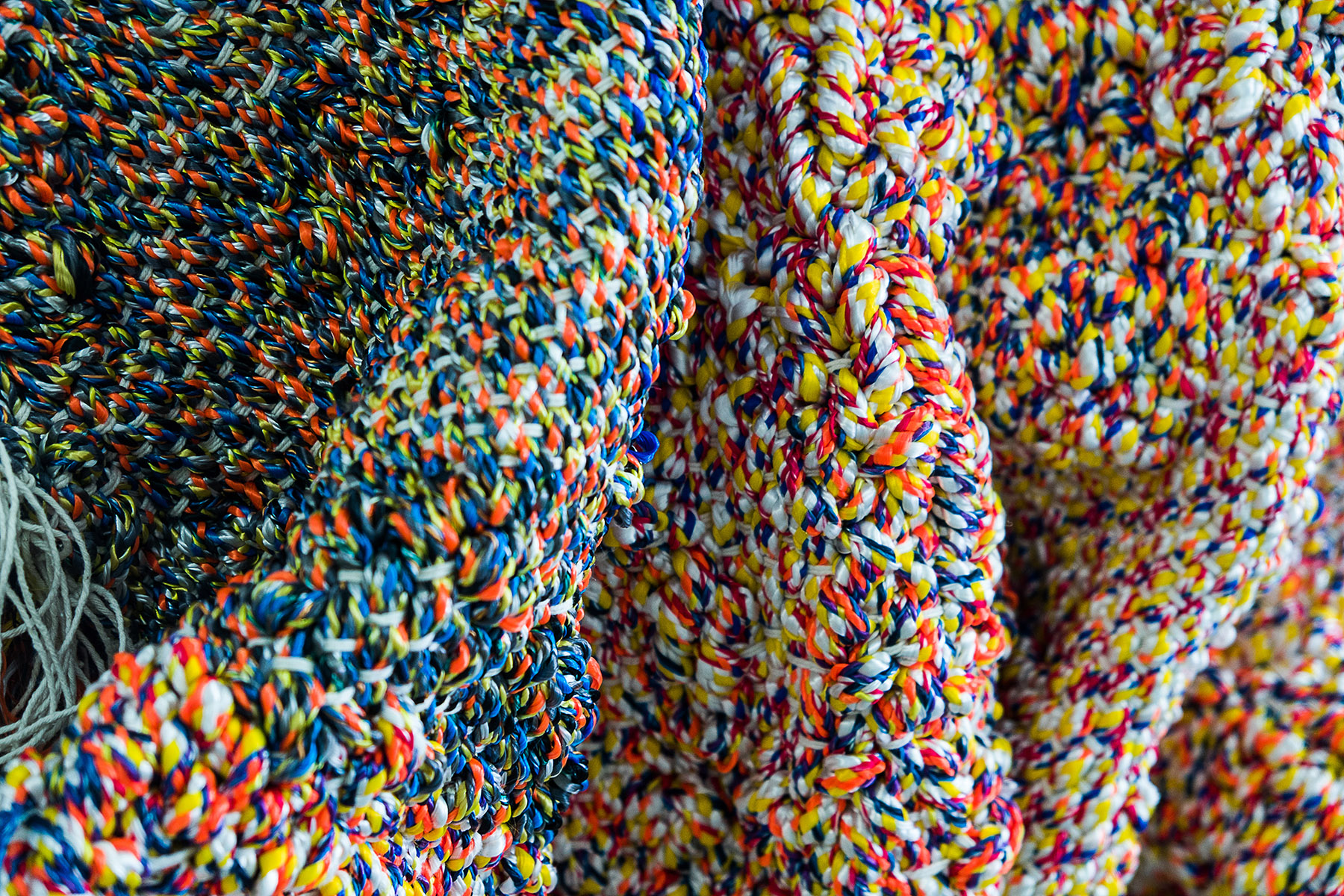Casey Kaplan


IGSHAAN ADAMS – MATERIAL TRACES
23 Jan 2019
By Jessica Hemmings
In this essay, Jessica Hemmings touches upon culture, faith and personal identity in the work of Igshaan Adams.
The synthetic rope that South African artist Igshaan Adams uses in his recent tapestry weavings comes from the Cape Town based Southern Rope company and always involves an element of chance. He works with the recycled version which means you are never quite sure if the colours visible on the outside of a spool will be consistent because various colours are re-twined by the manufacturers to create the new rope. The risk is a tolerable trade-off for Adams who explains that the colourful rope, a staple of his recent woven work, represents childhood memories of washing lines in the Cape Flats where he grew up. Born to Muslim parents and raised by his Christian grandparents in Bonteheuwel on the Cape Flats – “barren stretches of land south-east of Cape Town’s city bowl where coloured and black communities were forcibly moved to during apartheid” – biographic details are more than incidental to reading Adams’ diverse practice.
The history of Cape Malay culture arriving in the Cape Flats is one of upheaval. During Dutch colonisation of what is present day Indonesia, individuals were removed to yet another region of Dutch colonisation: South Africa. The first Cape Malay are understood to have been enslaved Javanese transported by the Dutch East India Company. Political dissidents and individuals opposed to the Dutch were exiled in South Africa with Cape Town acting as the convenient port for ships travelling between Asia and Europe to regularly stop, resupply and deliver dissidents. From 1654 onwards, these forced migrations brought Islam to South Africa and new vocabulary to the Afrikaans language. The complex frictions between culture, faith and personal identity, specifically Adams’ own homosexuality and the Islamic faith, remain themes throughout his current work informed by his Cape Malay culture. As Ala Rabiha Alhourani observes, “Adams describes that he had always felt out of place in every environment, no matter where he was – always Othered by one aspect of his identity against others.”
I find a small team of studio assistants weaving when I visit Adams’ studio in Cape Town where the final pieces for his solo exhibition “I am No More,” to be exhibited in early 2019 at Akershus Kunstsenter east of Oslo, are underway. Warp threads are stretched around nails strung from floor to ceiling; fork prongs tap down weft picks of multicoloured rope mixed with plastic and wooden beads. To create some of the earlier sack-like works (“Conduit I-V,” 2018) Adams shows me warps stretched around the perimeter of a cylinder. Weaving, quite literally, done in the round. He was introduced to weaving through teaching community arts workshops soon after graduation from the Ruth Prowse School of Art in Cape Town in 2009, although a keen attention to material predates this exposure to weaving. Justin Davy observes that the textile has been a constant presence in Adams’ work, seeing that “The presence of stray strands of thread and patches of various pieces of fabric lends the idea of the woven tapestry, albeit without the later specialised technique, to most of Adams’ early work. It seemed natural that at some stage Adams would incorporate the more formal process of tapestry weaving into his practice.”[iii] Tapestry weaving made its first appearance in this 2015 exhibition “Parda.” (The exhibition title refers to the thin cloth worn by some Muslim women as prescribed by Sharia law.) At the time Adams’ tapestries alluded to other versions of cultural veiling with many incorporating Arabic calligraphy with text from the Quran.
In his most recent work for his Akershus Kunstsenter exhibition, Adams works with the format of the prayer rug, abstracting imagery and combining multicoloured nylon rope, cotton twine, polyester, plastic, wooden and glass beads. Displayed on the wall, the weavings echo an earlier strategy to use worn linoleum flooring collected for large immersive installations. “This earlier period in Adams’ art-making is exemplified by his use of found objects, the marks left behind on their surfaces suggesting the physical space as a manifestation or reflection of our internal spaces.” But where flooring captures daily residue, prayer mats hold an inescapable association to faith. Adams has been quoted referring to prayer mats as:
“the silent records of our lives […] my friend gave me that [prayer mat] he had used for many years, possibly some thirty years. Look, there’s where the threads are worn through – the marks of his knees, where he was praying over and over. You can see where his feet and hands pressed in prayer. There’s where his forehead used to rest, you can make it out, it is worn down. It’s the imprint of his body acting on the prayer mat like marking on a canvas. A recording of the imprint of his body over all those years, acting on its surface, leaving its mark. This imprint might even outlast the person. This fascinates me.”
Read the full article HERE